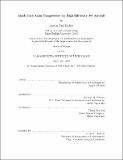Small core axial compressors for high efficiency jet aircraft
Author(s)
DiOrio, Austin Graf
DownloadFull printable version (1.906Mb)
Other Contributors
Massachusetts Institute of Technology. Dept. of Aeronautics and Astronautics.
Advisor
Edward M. Greitzer and Choon Sooi Tan.
Terms of use
Metadata
Show full item recordAbstract
This thesis quantifies mechanisms that limit efficiency in small core axial compressors, defined here as compressor exit corrected flow between 1.5 and 3.0 lbm/s. The first part of the thesis describes why a small engine core with high overall pressure ratio (OPR) is desirable for an efficient aircraft and shows that fuel burn can be reduced by up to 17% compared to current engines. The second part examines two specific effects: Reynolds number and tip clearance. At a core size of 1.5 lbm/s, Reynolds number may be as low as 160,000, resulting in reductions in stage efficiency up to 1.9% for blades designed for high Reynolds number flow. The calculations carried out indicate that blades optimized for this Reynolds number can increase stage efficiency by up to 1.6%. For small core compressors, non-dimensional tip clearances are increased, and it is estimated that tip clearances can be up to 4.5% clearance-to-span ratio at the last stage of a 1.5 lbm/s high pressure compressor. The efficiency penalty due to tip clearance is assessed computationally and a 1.6% decrease in polytropic efficiency is found for a 1% increase in gap-to-span ratio. At the above clearance, these efficiency penalties increase aircraft mission fuel burn by 3.4%, if current design guidelines are employed. This penalty, however, may be reduced to 0.4% if optimized blades and a smaller compressor radius than implied by geometric scaling, which allows reduced non-dimensional clearance, are implemented. Based on the results, it is suggested that experiments and computations should be directed at assessing: (i) the effects of clearance at values representative of these core sizes, and (ii) the effect of size on the ability to achieve a specific blade geometry and thus the impact on loss.
Description
Thesis (S.M.)--Massachusetts Institute of Technology, Dept. of Aeronautics and Astronautics, 2012. Cataloged from department-submitted PDF version of thesis. This electronic version was submitted and approved by the author's academic department as part of an electronic thesis pilot project. The certified thesis is available in the Institute Archives and Special Collections. Includes bibliographical references (p. 115-117).
Date issued
2012Department
Massachusetts Institute of Technology. Department of Aeronautics and AstronauticsPublisher
Massachusetts Institute of Technology
Keywords
Aeronautics and Astronautics.